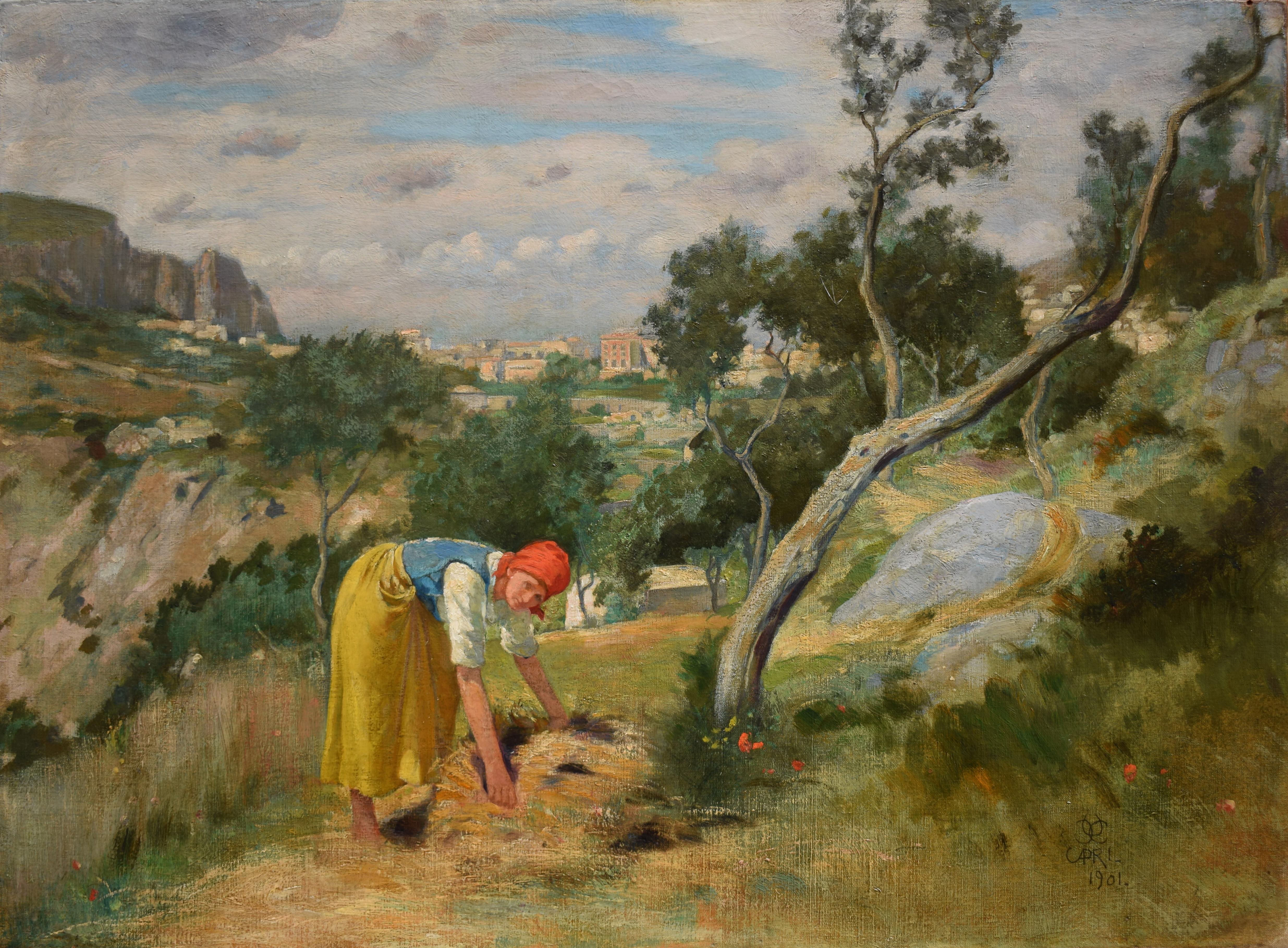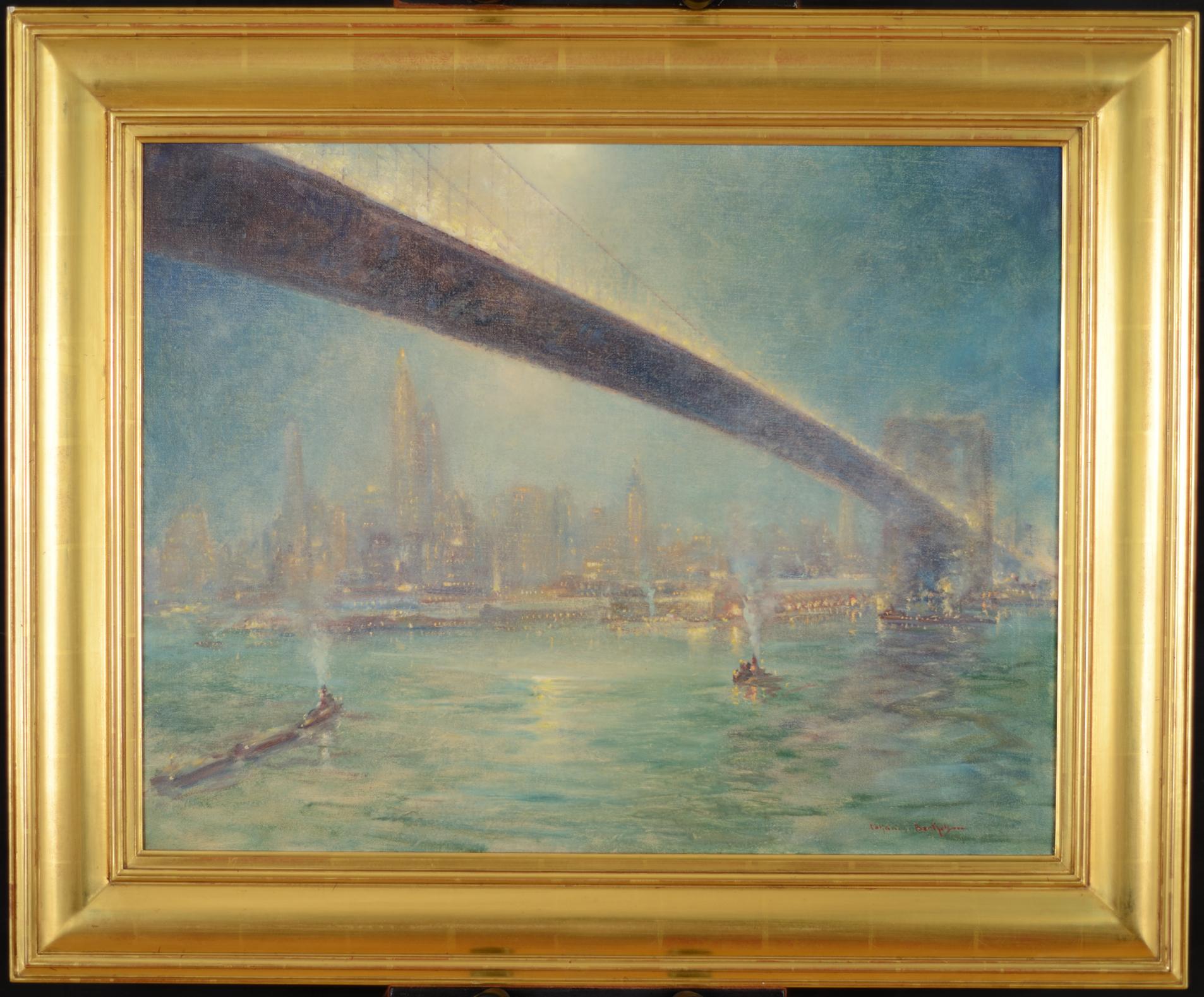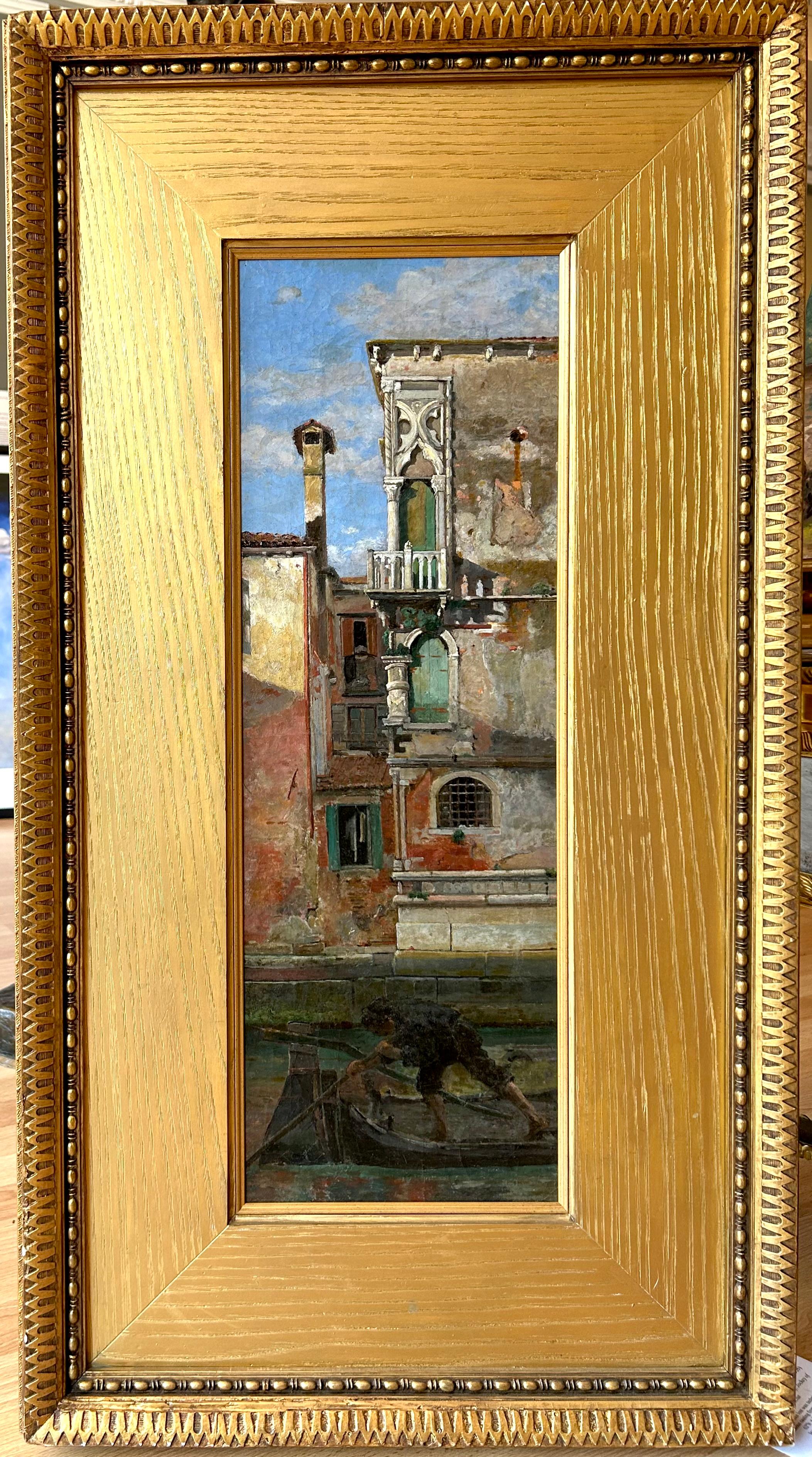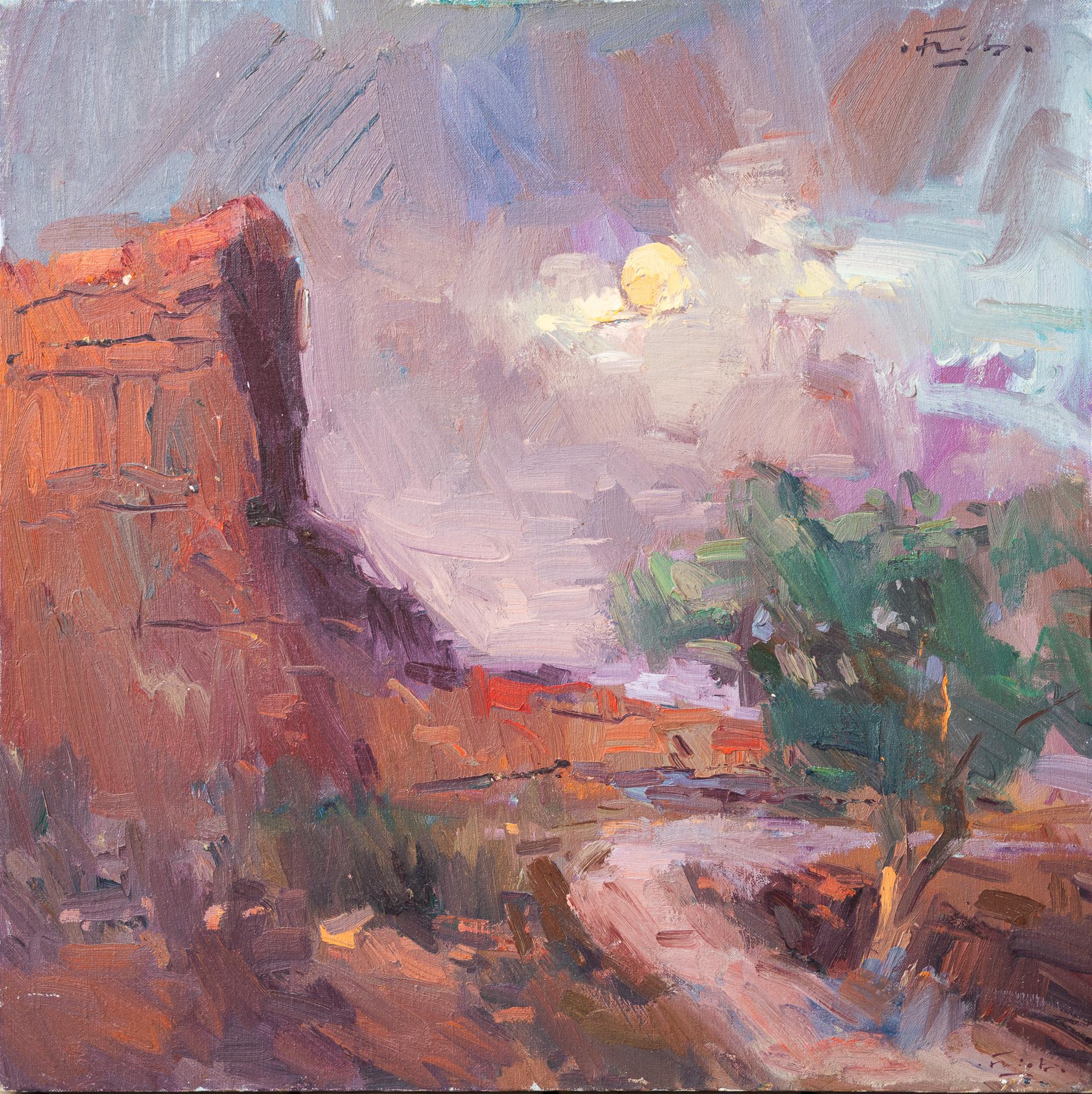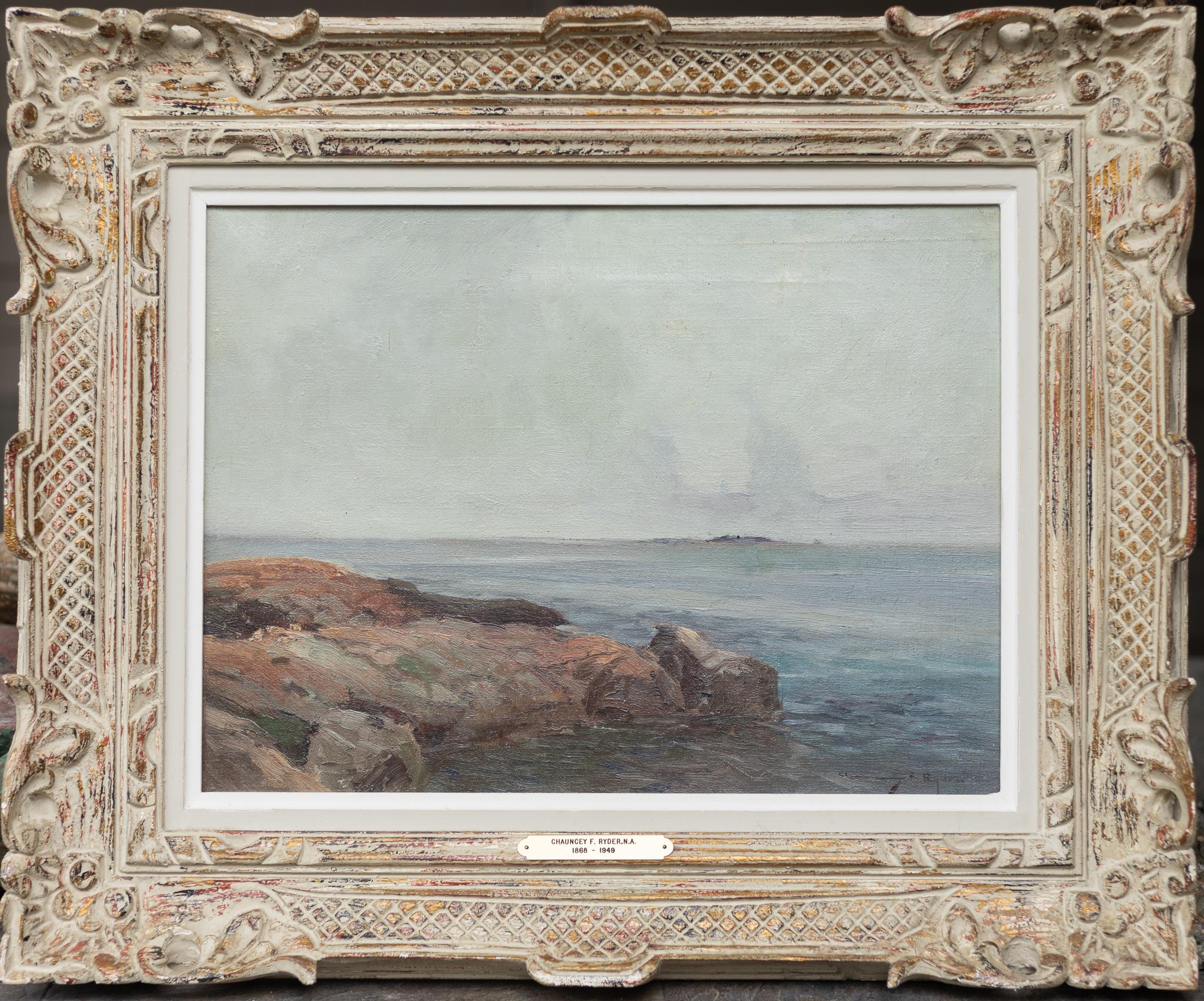Items Similar to "Beach, Haiti, " Gifford Beal, Sunny Seascape Resort, American Impressionist
Want more images or videos?
Request additional images or videos from the seller
1 of 9
Gifford Beal"Beach, Haiti, " Gifford Beal, Sunny Seascape Resort, American Impressionist1924
1924
About the Item
Gifford Beal (1879 - 1956)
Beach, Haiti, 1954
Oil on canvas
28 x 36 inches
Signed lower right
Provenance:
Estate of the artist
Kraushaar Gallery, New York
Exhibited:
Youngstown, OH, Butler Institute of American Art, 1955
Lincoln, MA, DeCordova and Dana Museum, 1955
New York, American Academy of Arts and Letters, 1956 and 1960
Fitchburg, MA, Fitchburg Art Museum, 1960
New York, Art Dealers Association of America, 1963
New York, Art Students League, 1975, New York, Kraushaar Galleries, Gifford Beal (1879-1956): Retrospective Exhibition of Paintings, Apr. 29 - May 29, 1975, no. 36
New York, Kraushaar Galleries, Gifford Beal (1879-1956): A Centennial Exhibition, Nov. 6 - Dec. 1, 1979, no. 26
Gifford Beal, painter, etcher, muralist, and teacher, was born in New York City in 1879. The son of landscape painter William Reynolds Beal, Gifford Beal began studying at William Merritt Chase's Shinnecock School of Art (the first established school of plein air painting in America) at the age of thirteen, when he accompanied his older brother, Reynolds, to summer classes. He remained a pupil of Chase's for ten years also studying with him in New York City at the artist's private studio in the Tenth Street Studio Building. Later at his father's behest, he attended Princeton University from 1896 to 1900 while still continuing his lessons with Chase. Upon graduation from Princeton he took classes at the Art Students' League, studying with impressionist landscape painter Henry Ward Ranger and Boston academic painter Frank Vincent DuMond. He ended up as President of the Art Students League for fourteen years, "a distinction unsurpassed by any other artist."
His student days were spent entirely in this country. "Given the opportunity to visit Paris en route to England in 1908, he chose to avoid it" he stated, "I didn't trust myself with the delightful life in ParisIt all sounded so fascinating and easy and loose." His subjects were predominately American, and it has been said stylistically "his art is completely American." Gifford achieved early recognition in the New York Art World.
He became an associate member of the National Academy of Design in 1908 and was elected to full status of academician in 1914. He was known for garden parties, circuses, landscapes, streets, coasts, flowers and marines. This diversity in subject matter created "no typical or characteristic style to his work."
Beal's style was highly influenced by Chase and Childe Hassam, a long time friend of the Beal family who used to travel "about the countryside with Beal in a car sketching local sights." Both Hassam and Chase were famous for their impressionist views of New York City and Connecticut and Long Island coastlines.
Beal's early work reflects his acquaintance with these painters and focused on the city's commercial and industrial growth. "Beal's major influence, however, remained Chase, whose "greatness" Beal attributed to the "sheer fullness of his naturehis store of energy," and his dedication to the profession of painting. "When the story of American art is finally told," Beal predicted, "Chase's name will be high on the list of the great."
Regarding his use of color, one art critic wrote: "On the whole he is inclined toward color that is rich and strong. The garden scenes have masses of deep and gleaming foliage over the gay scenes below. The circus pictures are resplendent in hue. He takes the rich green that crowns the cliffs at Montauk and with it gives depth and richness to their tawny sides. The ocean in Sword Fisherman is an intense blue, neither light nor dark, and full of almost imperceptible shadings."
Beal found early success with his views of the Hudson Valley where his family had an estate called Willellen in Newburgh, overlooking the Hudson River. A gifted technician and draftsman Beal did considerable mural painting including seven panels portraying the life of scientist John Henry; North Country and Tropical Country, Department of the Interior building, Washington, D.C and others. Renewing an early interest for the sea, a subject he had favored during his student years, Beal started to achieve recognition for his marine landscapes. In 1921 he began spending most of his summers on the Massachusetts coast, first at Provincetown and then at Rockport. Both he and his brother Reynolds had a strong attraction to the sea.
In the 1940's, Beal, never one to rest on his laurels made a dramatic stylistic change, his painting technique "became freer as he replaced naturalistic perspective with an intricately patterned and flattened picture plane." These "more decorative" works echoed ancient Persian paintings as well as the work of Maurice and Charles Prendergast whose art Beal greatly admired. In the end he adopted a "less objective" style that was high key and "utilizing softer edges." This new work was said to be influenced by Raoul Dufy. However many influences one may choose to cite in Beal's work this is secondary to the fact that Gifford Beal throughout his artistic career derived a strongly personal statement in his art that was "fundamentally sound and aesthetically pleasing."
Beal's paintings have been exhibited at the National Academy of Design, 1901-1921, 1923, 1930-1938, 1942-1943, 1947-1952, 1954-1956; Worcester Art Museum (prize), 1903; Art Institute Chicago, 1904, 1909-1919, 1921,1923-1932, 1934, 1936-1944, 1946 and 1949; Pennsylvania Academy of Fine Arts, 1904, 1906, 1908-09, 1911-12, 1914-16, 1918-20, 1924-26, 1929-30, 1932-47, 1950, 1952 and 1956; St. Louis Exposition (medal) 1904; Armory Show, 1913; Corcoran Gallery, Washington, DC; Panama Pacific Exposition, (medal) 1915; Society of Independent Artists, 1917; Kraushaar Galleries; International Exposition, Paris; Carnegie Institute; Retrospective Exhibition, Century Club, NY; San Francisco Museum; San Joaquin Museum; Des Moines Art Center; Butler Institute; Scripps College; American Academy of Arts and Letters; Phillips Collection; Montclair Art Museum and others. He was a member of the American Academy of Arts and Letters, the American Institute of Arts and Letters, the Architectural League of America, and the National Society of Mural Painters. His work can be found in numerous museums and public collections across the country.
- Creator:Gifford Beal (1879-1956, American)
- Creation Year:1924
- Dimensions:Height: 37 in (93.98 cm)Width: 44 in (111.76 cm)
- Medium:
- Movement & Style:
- Period:
- Condition:
- Gallery Location:New York, NY
- Reference Number:1stDibs: LU1841210510842
About the Seller
5.0
Platinum Seller
These expertly vetted sellers are 1stDibs' most experienced sellers and are rated highest by our customers.
Established in 2021
1stDibs seller since 2022
60 sales on 1stDibs
Typical response time: 1 hour
- ShippingRetrieving quote...Ships From: Larchmont, NY
- Return PolicyA return for this item may be initiated within 3 days of delivery.
More From This SellerView All
- "View of Boats in Gloucester Harbor, " Emile Gruppe, American ImpressionismBy Emile Albert GruppeLocated in New York, NYEmile Albert Gruppe (1896 - 1978) View of Boats in Gloucester Harbor, Cape Ann, Massachusetts circa 1925 Oil on canvas 25 x 30 inches Signed lower right Emile Gruppe was an unusually prolific artist. He was at his easel almost every day and created thousands of paintings over a career that lasted 60 years. At his peak, he was completing almost 200 oil paintings a year. Yet he has never failed to find an audience for his depictions of New England in autumn and winter, or his harbor scenes of Rockport and Gloucester in Massachusetts. Gruppe was born in 1896 in Rochester, New York to an artistic family--his father, brother, sister and nephew were all artists. Emile spent his youth in Katwyk an Zee, a fishing village in Holland, where his father, Charles Gruppe, worked as both an artist and an art dealer. Emile lived in the Netherlands until he was 17, when the family returned permanently to the United States to avoid World War I. In New York City, Gruppe attended classes at the National Academy of Design and at the Art Students League, where he studied under Charles Chapman and George Bridgman. He also studied with John Carlson in Woodstock, New York, where he gained an appreciation for outdoor painting. Carlson “turned me into a painter,” he later said. Gruppe helped found the Rockport Art Association in 1921, but he is most closely linked to Gloucester where he lived from about 1940 until his death. He operated the Gloucester School of Painting from the 1940s into the 1970s and helped turn the Rocky Neck area of East Gloucester into a world-famous art colony. The school boasted an impressive faculty but Gruppe’s own exuberant plein-air demonstrations were often the highlight of the week. Gloucester, with its fleet of whimsically painted fishing vessels, crowded wharf buildings and shacks, and picturesque inhabitants, never ceased to fascinate Gruppe. He also helped popularize Rockport’s famous fishing shack known as Motif #1, sometimes called “the most often-painted building in America.” By the 1940s, Gruppe was one of the most prominent of the Cape Ann artists...Category
1920s American Impressionist Landscape Paintings
MaterialsCanvas, Oil
- "Elegant Lady in Winter, Trinity Church, New York" Herman Hyneman, Gilded AgeBy Herman HynemanLocated in New York, NYHerman N. Hyneman (1849 - 1907) Elegant Lady in Winter, Trinity Church, New York City Oil on canvas 22 x 15 inches Signed lower right Provenance: Freemans, 2005, Lot 76 Herman N. Hyneman was a noted American portrait and figure painter with ties to both Philadelphia and New York. He was born July 27,1849 to Leon and Adeline Hyneman in Philadelphia. ("Who Was Who in American Art" lists his birth date as either 1849 or 1859, but we have confirmed that the birth date is 1849). Virtually nothing is known about his early years, but given the fact that the family resided in a wealthy section of Philadelphia and the fact that he traveled to Paris to study in the studio of Leon Bonnat when he was but 20 years old, it is presumed that the family was financially comfortable if not well to do. Hyneman exhibited at the Paris Salon in 1879 and 1881, which was quite an accomplishment given his tender age. He returned to the United States in 1882 and after a year in Philadelphia, he established a studio at 58 West 57th Street, New York, NY, where he painted portraits to support himself and scenes of beautiful fair-skinned women walking in the snow to exhibit at major exhibitions throughout the United States. Hyneman exhibited at the the Brooklyn Art Association in 1882, 1883 and 1884 and at the Pennsylvania Academy of Fine Arts in 1883 and 1888. Beginning in 1882 and continuing up until 1905, he exhibited regularly at the National Academy of Design. Despite the fact that he exhibited fourteen paintings at the National Academy over a span of three different decades, he was never elected as a member. In the 1880's his paintings sold for between $100 and $1500, which were substantial sums for that period. Hyneman also exhibited at the Salmagundi Club and the Philadelphia Art Club and was a member of each organization. He won a medal at the American Art Society in 1904 and also exhibited at the Chicago Art Institute. A handwritten label on one of his paintings indicates that he also exhibited in Budapest, Hungary. In 1892, Hyneman married the noted artist Juliet Jolley (aka Jolly), who had previously modeled for him. Thereafter, they shared a studio and on at least one occasion exhibited together. The February 5, 1896 edition of the "New York Times" reported on a "pleasant studio reception" at 58 West 57th Street where the paintings of both Herman and Juliet were shown to members of New York Society including Mr. And Mrs. Edwin Blashfield. At least one of Hyneman's Painting " A Sensation on Wall Street" which depicted a lovely young woman in fur coat with Muff in front of the Stock Exchange, was made into a post card and reproductions of his paintings are known to exist, although not plentiful. At least one etching is known, "Desdemona," which was reproduced in a book by Frederic Stokes. Herman Hyneman...Category
Late 20th Century American Impressionist Landscape Paintings
MaterialsCanvas, Oil
- "The Green Parasol, " Henry Hannig, American Impressionist, Woman in Beach SceneBy Henry HannigLocated in New York, NYHenry Charles Hannig (1883 - 1948) The Green Parasol Oil on canvas mounted on board 6 x 7 3/4 inches Provenance: R.H. Love Galleries, Chicago, Illinois Private Collection, Lake Orion, Michigan Hannig, born in Hirschberg, Germany on 27 February 1883, came to America with his parents at the age of seven. He attended school in the southwest suburbs before the family settled in Chicago. Young Henry enrolled in the Chicago Academy of Fine Arts where Lawton Parker became his mentor. He made ends meet by working in industrial design and illustration. By 1908 he was a pupil in the School of the Art Institute of Chicago where students followed the traditional European drawing curriculum, beginning with the copying of master engravings and drawing after plaster casts, then concentrating on the nude figure. Students worked toward the goal of winning various academic prizes. One of Hannig's fellow students was Louis Ritman...Category
1910s American Impressionist Figurative Paintings
MaterialsCanvas, Oil, Board
- "Wellfleet, Cape Cod, " Gerrit Beneker, American Impressionism, ProvincetownBy Gerrit BenekerLocated in New York, NYGerrit Beneker (1882 - 1934) Wellfleet, Cape Cod, Massachusetts, New England, 1926 Oil on canvas 20 x 16 inches Signed, titled, and dated lower left Provenance: Louis H. Barnett, Fort Worth, Texas In 1905, Gerrit Beneker began his art career as an illustrator. He married Flora Judd, his high school sweetheart from Grand Rapids and they moved to Brooklyn, NY. Gerrit's early passion was to create an art that would inspire and provide honor to the workingman. As such, he had no interest in painting portraits of pretty women, which were so often seen on the magazine covers of the day. Rather he wanted to seek out workingmen on the bridges, tunnels and skyscrapers of NYC, and paint them in their environments. He completed over 150 magazine covers, numerous ads including many for Ivory Soap...Category
1920s American Impressionist Landscape Paintings
MaterialsOil, Canvas
- "Trinity Church, Boston" Arthur Clifton Goodwin, Impressionism, Snowy WinterBy Arthur Clifton GoodwinLocated in New York, NYArthur Clifton Goodwin Trinity Church, Boston, 1928 Signed lower left Oil on canvas 30 x 36 inches Provenance: Sotheby’s New York, American Art, May 24, 1990, Lot 166 Private Collec...Category
1920s American Impressionist Landscape Paintings
MaterialsCanvas, Oil
- "A Man in His Garden, " Emil Carlsen, Backyard and Barn Impressionist LandscapeBy Emil CarlsenLocated in New York, NYSoren Emil Carlsen (1848 - 1932) A Man in His Garden, 1893 Oil on canvas 28 3/4 x 35 1/2 inches Signed and dated lower right Provenance: The artist [1848-1932] Macbeth Gallery, New ...Category
1890s American Impressionist Landscape Paintings
MaterialsCanvas, Oil
You May Also Like
- Peasant woman at work in the fields of CapriBy Charles Caryl ColemanLocated in Roma, RMCharles Caryl Coleman (Buffalo 1840 – Capri 1928), Peasant woman at work in the fields of Capri (1901) Oil painting on canvas 35 x 49 cm, signed, located and dated Capri 1901 lower ...Category
Early 1900s American Impressionist Landscape Paintings
MaterialsCanvas, Oil
- Bridge Nocturne oil painting by Johann BerthelsenBy Johann Berthelsen, 1883-1972Located in Hudson, NYOne of Johann Berthelsen's iconic nocturne views of New York City across the Hudson River. Bridge Nocturne (c.1945) Oil on canvas, 22" x 28" 29 ½" x 36" x 2" framed Signed "Johann ...Category
1940s American Impressionist Landscape Paintings
MaterialsCanvas, Oil
- Oil Landscape of Italy Corner of Piazzo Del CampoBy William GrahamLocated in Fredericksburg, VAThis wonderful oil on canvas landscape was done by the famed William Graham. William Graham was an American landscape painter who spent most of his life and career abroad. He was bor...Category
Late 19th Century American Impressionist Landscape Paintings
MaterialsCanvas, Oil
- Impressionist Italian Landscape of River and VillasBy William ChadwickLocated in Fredericksburg, VAThis landscape of a river with Italian vistas was painted in 1911 by William Chadwick. This was an American artist born in England and lived in Massachusetts. He is famous for his Am...Category
Early 19th Century American Impressionist Landscape Paintings
MaterialsCanvas, Oil
- "Moon Over Monument Valley"Located in Austin, TXAn American Impressionist depiction of a moonlit night in Monument Valley, Arizona. It features a palette of purple, pink, and dark blue. Artist: Guido Frick...Category
21st Century and Contemporary American Impressionist Landscape Paintings
MaterialsCanvas, Oil
- "Costal Scene" Early 20th Century SeascapeBy Chauncey Foster RyderLocated in Austin, TX"Coastal Scene" is an original oil painting by Chauncey Ryder that depicts a serene, misty seascape. The foreground features a rock formation with patches of green moss emerging from...Category
20th Century American Impressionist Landscape Paintings
MaterialsOil, Canvas
Recently Viewed
View AllMore Ways To Browse
American Dealers
Paintings Of Famous Americans
Impressionist Art Beach
Impressionist Beach
Impressionist Painting Beach
Ancient American
Ancient America
1960 Early American
Bee With
Early American Pictures
American Plein Air Artists
Seascape Impressionist
Impressionist Seascape Painting
American Seascape
1960s Beach
American Seascape Paintings
Impressionist Architecture
1900 American Paintings
